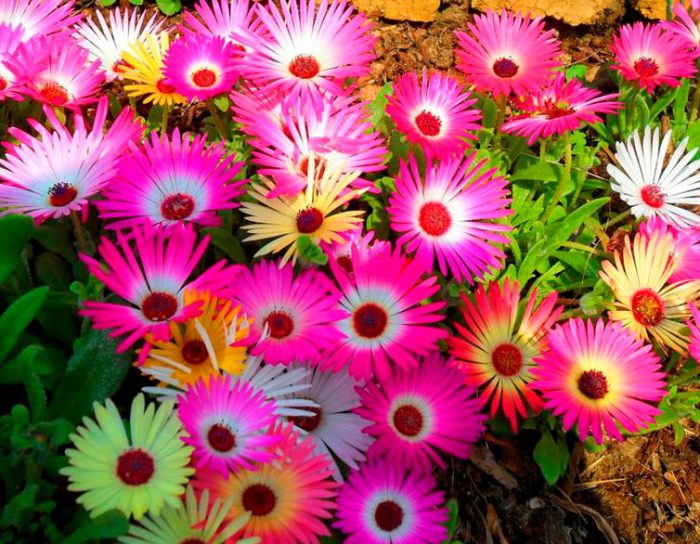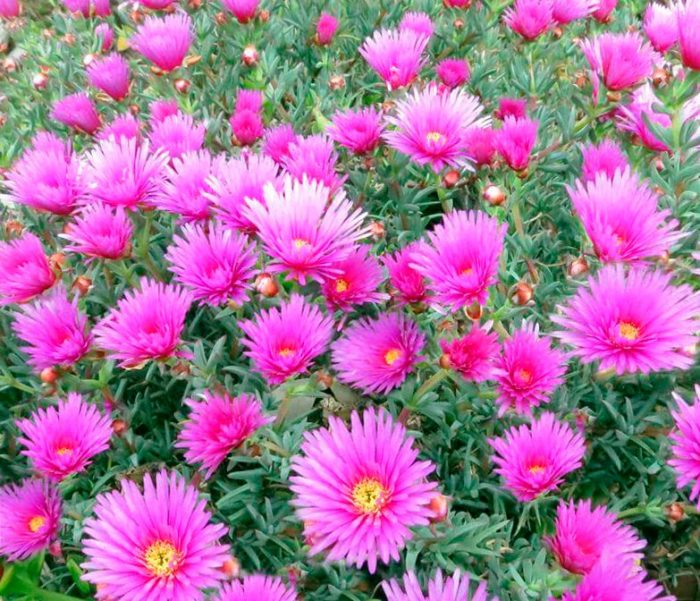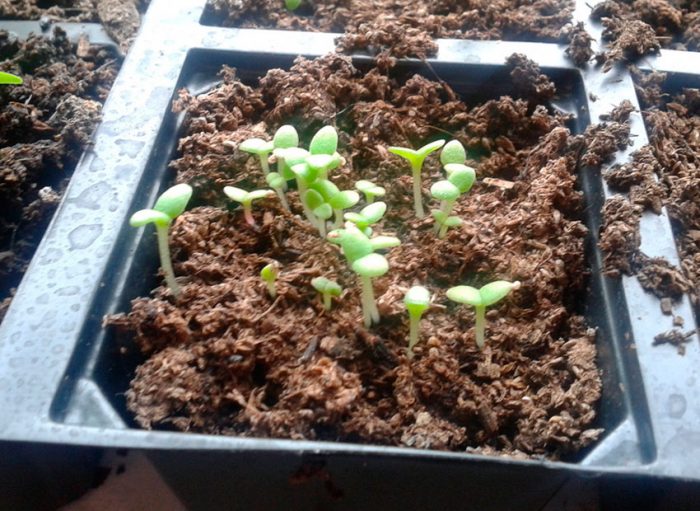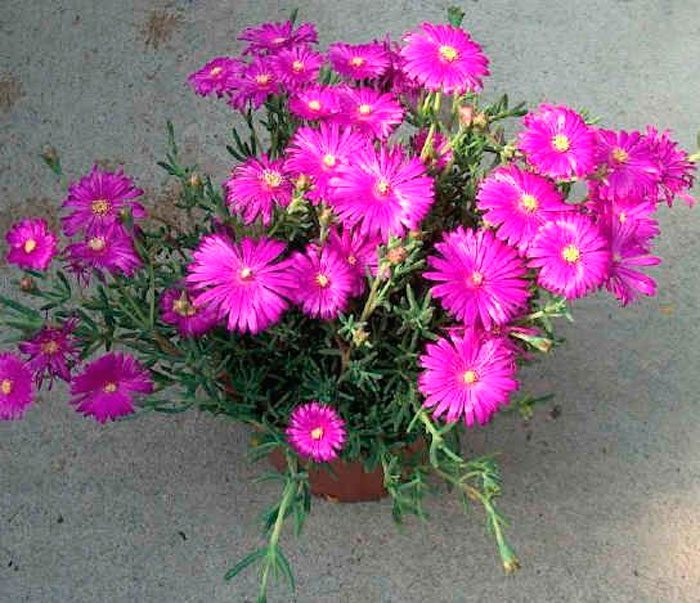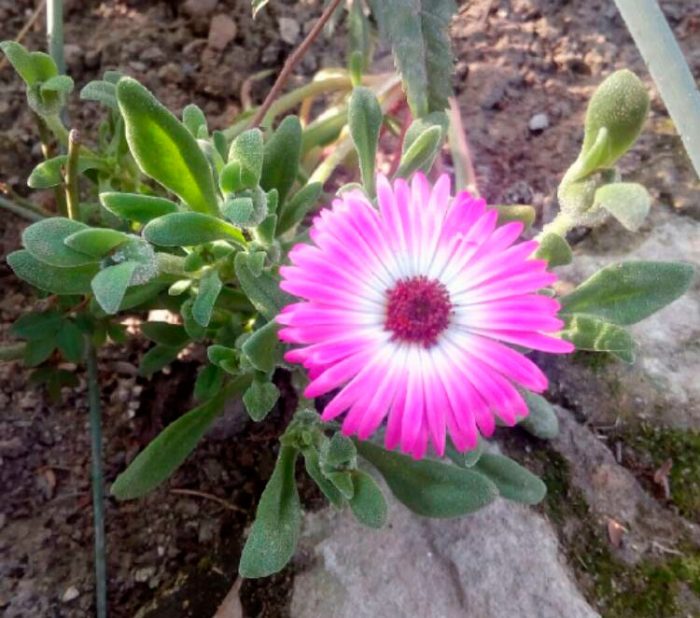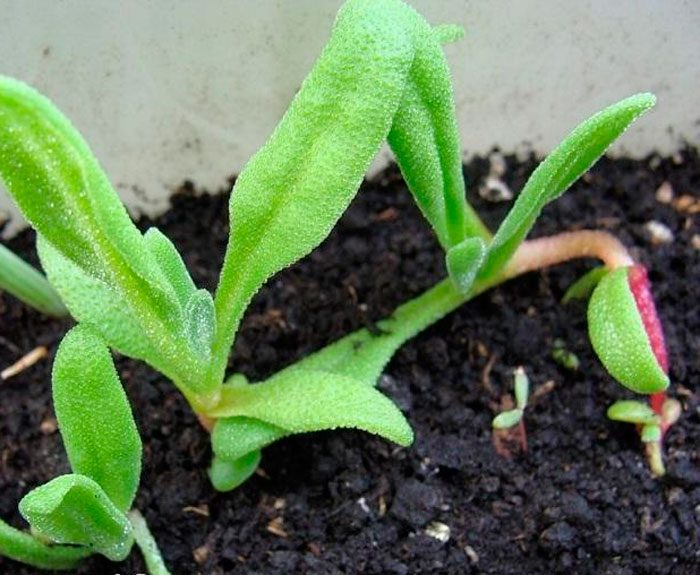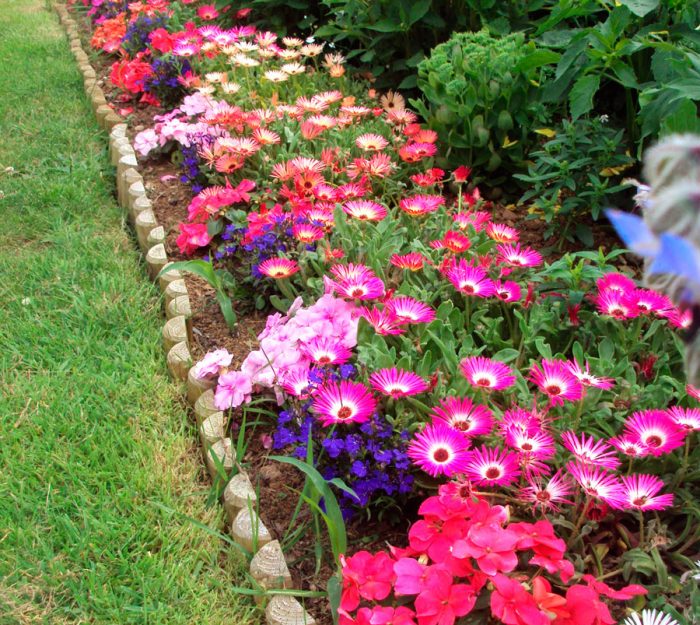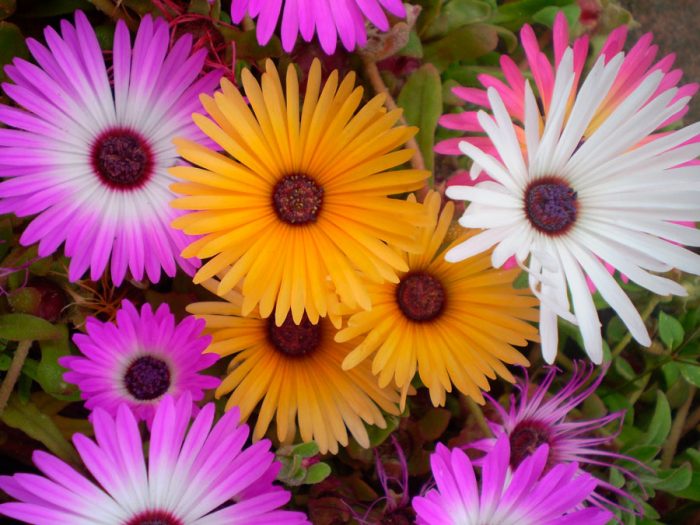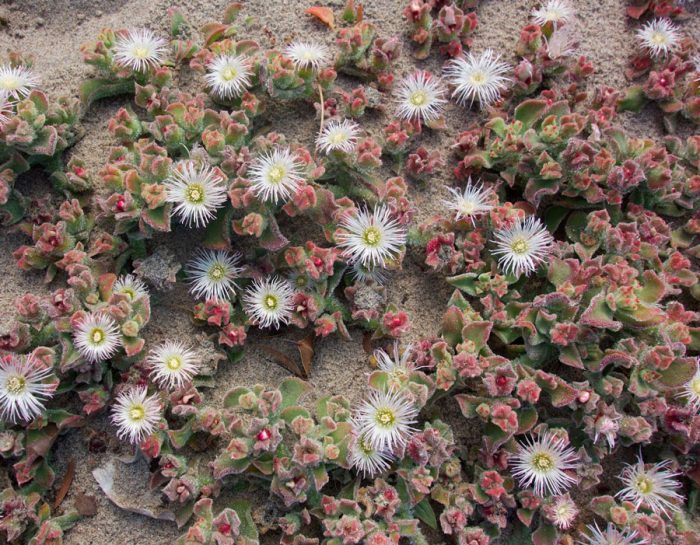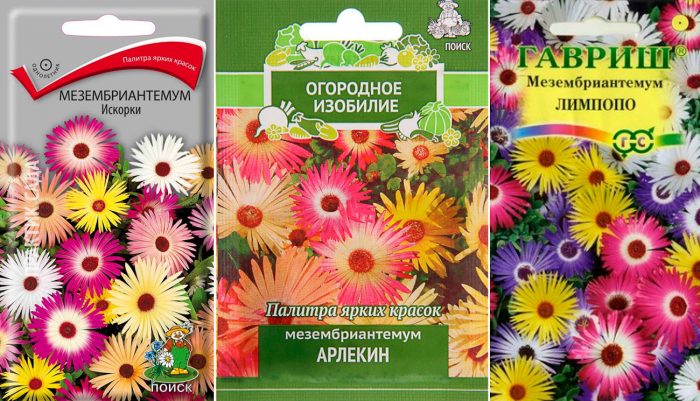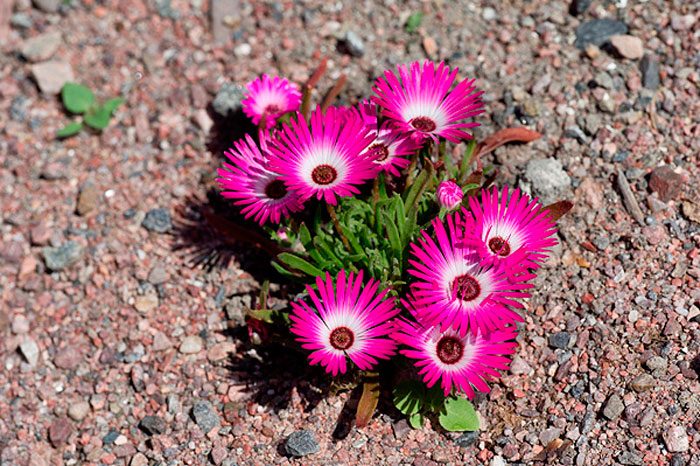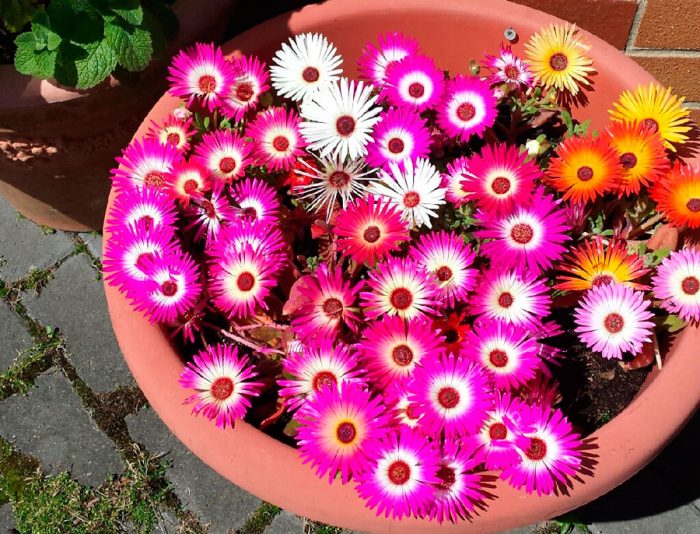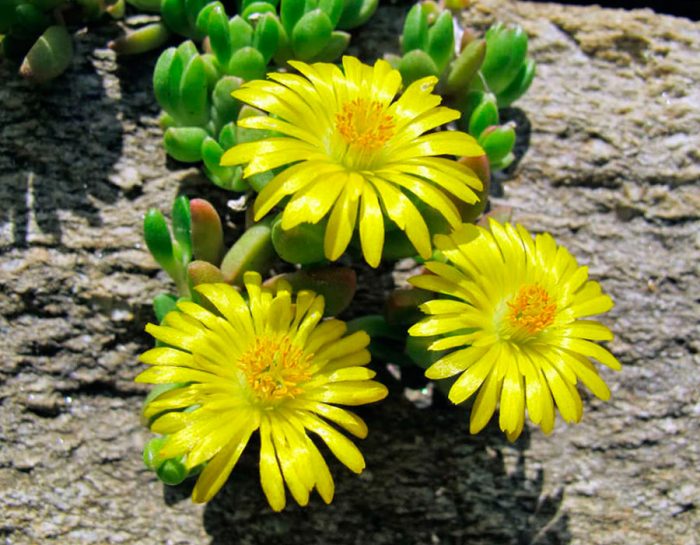Mesembryanthemum is a succulent annual or biennial plant that is a member of the Azizov family. In nature, it is found in South Africa. This plant was called the mesembriantemum in 1684, from Greek this name is translated as "midday flower", because the mesembriantemums known at that time united such a feature as the opening of flowers only in sunny weather. This plant is also called "midday" or "sunflower". But in 1719, species were found that bloom only at night. According to various sources, this genus unites from 50 to 80 species.
Content
Features of the mesembryanthemum
The genus mesembriantemum is represented by not very tall creeping or creeping plants, and in some cases by dwarf shrubs, having a height of no more than 15 centimeters. Strongly branching recumbent shoots are usually straight. Fleshy sessile greenish leaf plates have a fusiform or rounded shape. In the upper part of the stem, they are placed alternately, and in the lower part, opposite. On the surface of the leaf plates there are superficial swollen cells called idioblasts, which outwardly look like small balls of crystal, because of them this culture is also called ice or crystal grass. The flowers of such a plant are similar to daisies. They are collected in brushes, or they can be single. Flowers are painted in a variety of colors: white, pink, red, and sometimes yellow. Such a plant blooms throughout the summer, and fades in mid-autumn. The fruit is a five-leaf box with small seeds inside. They remain viable for 1–2 years. This crop is grown both indoors and in open soil.
Caring for the mesembriantemum at home
Growing from seeds
Sowing seeds of mesembryanthemum directly into the soil is possible only in the southern regions.In middle latitudes, seedlings of such a plant are first grown, while sowing is carried out in the first half of April. It is not worth sowing seeds earlier, because the seedlings need a lot of light. To grow seedlings, you need a breathable light soil mixture, which should consist of coarse sand, peat and garden soil (2: 2: 1).
Before planting, the substrate must be disinfected; for this, it is calcined in the oven or spilled with a solution of potassium permanganate. Then the surface of the soil mixture is leveled and removed to a warm place for 15 days, during which time beneficial microorganisms necessary for the plants should multiply in the substrate. The seeds must be evenly distributed over the surface of the soil mixture, which must be pre-moistened, then they are slightly pressed into the substrate, but not covered with the substrate. The container must be covered with glass or foil, and then it is removed to a well-lit cool (15-16 degrees) place before the seedlings appear. After about 7 days, the first seedlings should appear, when this happens, the plants are removed to a cooler place (from 10 to 12 degrees). The mass appearance of seedlings occurs only after 3-4 weeks.
How to water and feed
The development of fragile seedlings is extremely slow, and they also do not have resistance to root rot, in this regard, in order to grow seedlings of such a culture, it must be properly watered. The greenhouse where the seedlings grow must be well ventilated, while the soil mixture should always be slightly damp. To moisten it, use a spray bottle. After the plant grows stronger, and they have 2 true leaf plates each, they should be cut into individual containers (plastic cups or pots), which are filled with the same soil mixture, but it should be noted that there should be a lot of sand in it. It is not necessary to feed such a plant during the seedling period.
Planting and caring for the mesembriantemum in the open field
What time to plant
In open soil, seedlings of mesembryanthemum should be planted only after the return spring frosts are left behind, and warm weather sets in, while the ground should be well warmed up, as a rule, this time falls on the second half of May or the first days of June.
To grow such a culture, it is recommended to choose a ventilated area that has reliable protection from drafts and is illuminated by the sun throughout almost the whole day. These flowers will grow best in an area located in the southern part of the garden. The soil should be well-drained, rocky or sandy. Before you start planting, you should dig up the soil, and you need to add expanded clay, as well as sand. This plant is not recommended to be planted near moisture-loving crops, the fact is that the bushes rot in excessively moist soil.
Landing rules
It is very easy to grow a mesembriantemum in your garden. Before starting planting, it is necessary to make planting holes in the prepared area, while their depth should be such that the plant can fit in them along with a lump of earth and roots. A distance of at least 15–20 centimeters should be maintained between the pits. After planting seedlings, the free space in the planting pits must be covered with moisture-permeable loose soil. When the plants are planted, the soil needs to be watered and tamped a little.
How to care for the garden
Watering such flowers should be moderate and timely. Watering is carried out only when the soil dries out well and it will be seen that the bushes are suffering from a lack of water. If it often rains in the summer, then such a culture can be very badly affected, in this regard, experts recommend covering the site with a film in damp weather, as a result, the soil will not sour from water. The plots are fertilized once every 15–20 days.For feeding, a solution of complex fertilizers for succulent plants is used.
You do not need to cut the bushes, on the contrary, the flowering shoots creeping along the site turn the flower bed into a colorful spectacular carpet. If you take care of the bushes correctly, then their flowering can last until the second half of the autumn period.
Wintering
Bushes for the winter must be removed from the soil, while all excess soil must be removed from the root system. They are stored for storage in a cool place (from 10 to 12 degrees), while in spring, when the growing season begins, the bushes must be cuttings. Rooting of cuttings should be carried out with poor watering and under diffused bright light, and when the frost passes, they should be planted in open soil.
Diseases and pests of the mesembryanthemum
Diseases
This crop, when grown in open soil, has a fairly high resistance to both diseases and harmful insects. Most often, it suffers due to unfavorable weather conditions, or rather, high humidity or due to improper irrigation. If moisture stagnation is observed in the soil, then the bushes can be affected by root rot, while it is almost impossible to cure diseased plants. You can trim off the affected areas of the root system and spray the bushes with a fungicide, but the chances are that this will not help them.
If the bushes are planted in a shaded place, then they may not bloom at all, because they need a lot of sunlight, while direct rays do not harm them at all. If the mesembriantemum lacks light, then it will become elongated and take on a painful appearance. Bushes also become less attractive if they lack the nutrients in the soil.
Harmful insects
Spider mites can settle on the bushes, which prefer to live in exactly the same conditions as the mesembriantemum, but these pests can suffer due to high humidity. To get rid of ticks, you need to use acaricides, for example, Aktara, Fitoverm, Aktellik or Akarin.
Types and varieties of mesembriantemum with photos and names
Today, gardeners cultivate not a very large number of varieties and types of mesembryanthemum; their description will be given below.
Crystal mesembryanthemum (Mesembryanthemum crystallinum)
Or mesembriantemum crystallinum, or crystal grass. This species comes from the deserts of South Africa. Such a wide-spreading perennial reaches a height of about 15 centimeters. It has a large number of shoots that adorn small fleshy leaf plates of an oval shape and greenish color, while their edges are wavy. The flowers are outwardly similar to daisies or daisies. This view is described in more detail at the beginning of this article. The following varieties are popular:
- Sparkles... The leaf plates are whitish-yellow. The flowers are of various colors, and in diameter they reach about 45 mm.
- Harlequin... The petals have a double color, namely, pink and orange.
- Limpopo... This variety includes varieties of various colors.
Mesembryanthemum gramineus, or tricolor
Such a branchy annual reaches a height of 12 centimeters. Shoots have a pale red color. Fleshy linear leaf plates reach 50 mm in length, with hairs on their surface. The color of the flowers is carmine-pink, closer to the middle they are painted in a darker color shade, in diameter they reach 36 mm.
Mesembryanthemum bellidiformis, or hairy-flowered mesembryanthemum
An annual branched plant reaches a height of 10 centimeters. The length of the fleshy leaf plates is about 75 mm, they are obovate, and there are papillae on their surface.The flowers reach 30–40 mm in diameter, they are colored pink, orange, bright purple, red, apricot, yellow or purple. Their disclosure takes place only on a fine day.
Cloud Mesembryanthemum (Mesembryanthemum nubigenum)
This succulent is cultivated as a ground cover plant, but in natural conditions it is a semi-shrub. The height of the bush varies from 60 to 100 mm. The leaf plates are oval or linear. When the temperature drops, the bushes turn bronze. The species is hardy and has a short flowering period. Narrow petals can be colored yellow-gold, orange, red or purple. The diameter of the flowers is about 35 mm.
Mesembryanthemum occulatus
The species has an unusual color, which explains its great popularity among gardeners. The petals are colored deep yellow, while the stamens, pistil and center of the head are bright red. The height of the bush is about 10 centimeters. The length of the spatulate-lanceolate leaf plates is 10–45 mm.
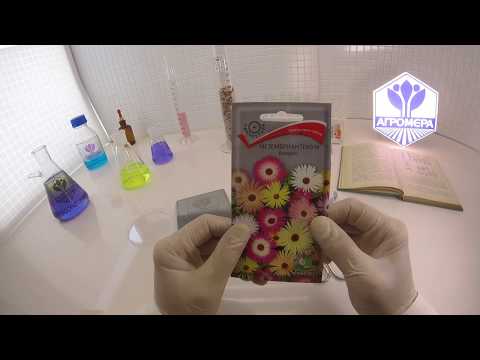

Watch this video on YouTube

